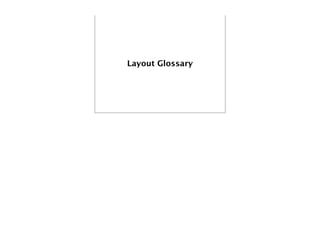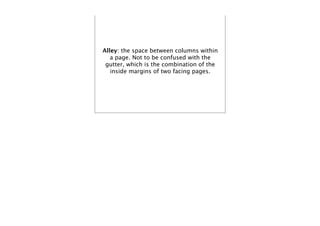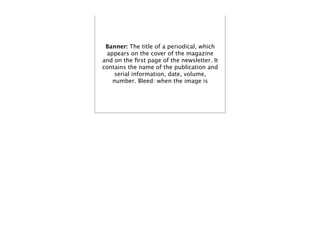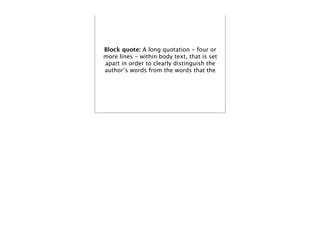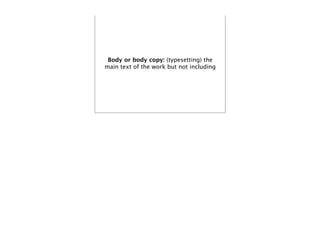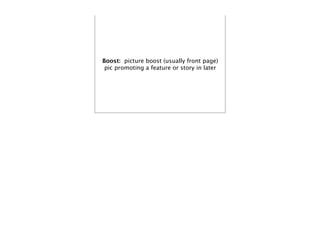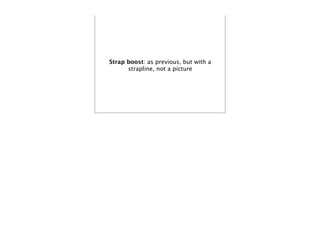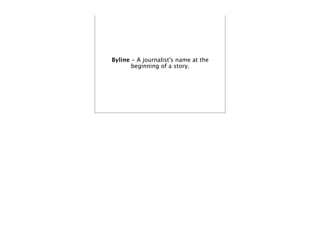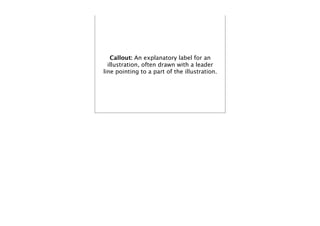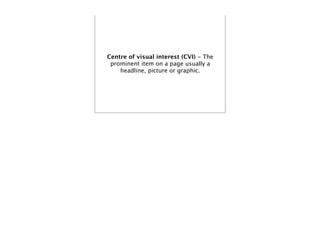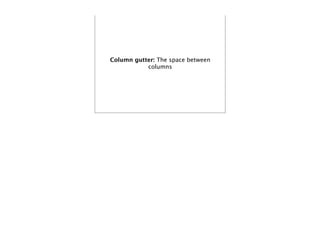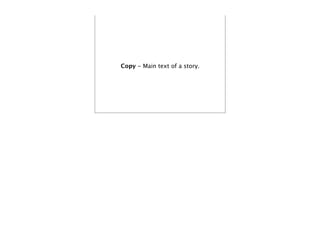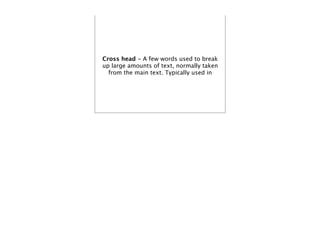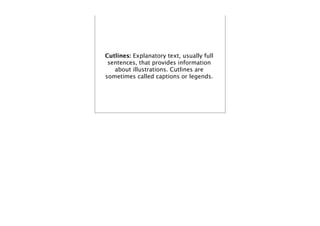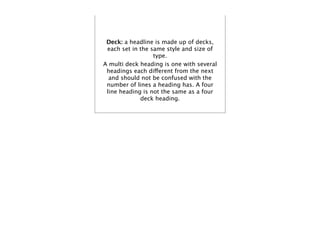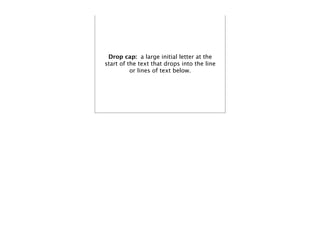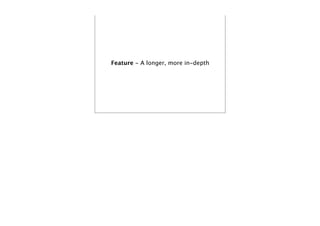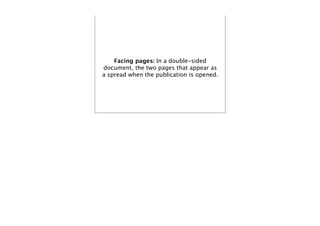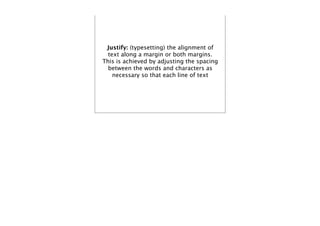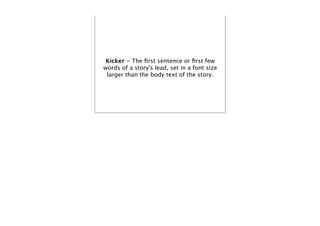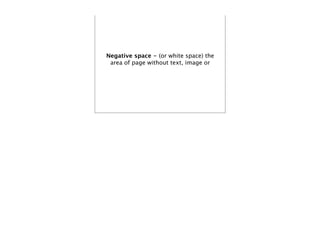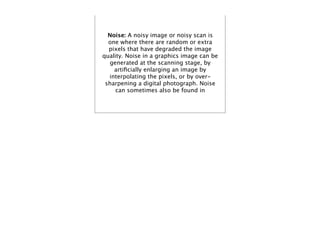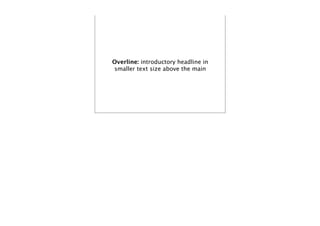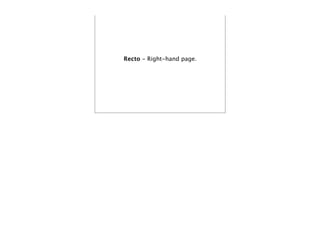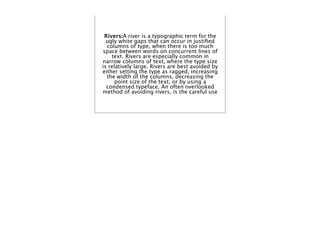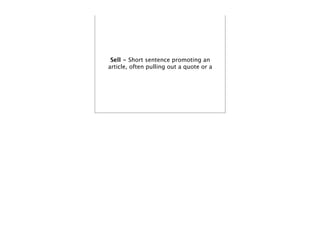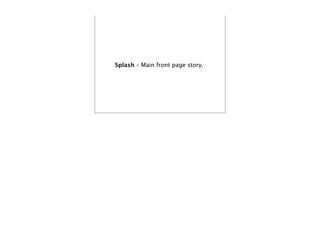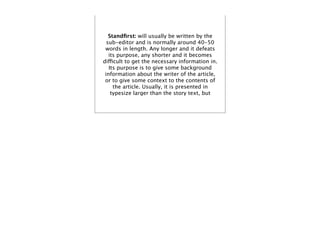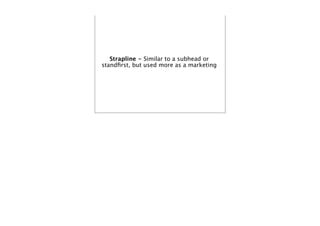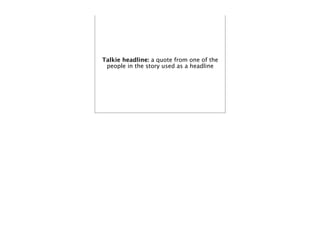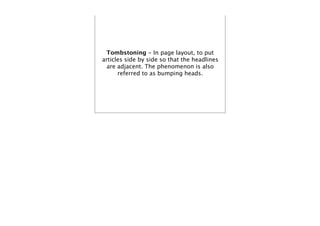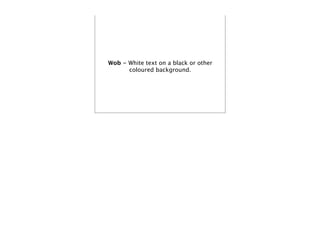Layout glossary
- 2. Alley: the space between columns within a page. Not to be confused with the gutter, which is the combination of the inside margins of two facing pages.
- 3. Banner: The title of a periodical, which appears on the cover of the magazine and on the ’¼ürst page of the newsletter. It contains the name of the publication and serial information, date, volume, number. Bleed: when the image is
- 4. Block quote: A long quotation - four or more lines - within body text, that is set apart in order to clearly distinguish the authorŌĆÖs words from the words that the
- 5. Body or body copy: (typesetting) the main text of the work but not including
- 6. Boost: picture boost (usually front page) pic promoting a feature or story in later
- 7. Strap boost: as previous, but with a strapline, not a picture
- 8. Byline - A journalist's name at the beginning of a story.
- 9. Callout: An explanatory label for an illustration, often drawn with a leader line pointing to a part of the illustration.
- 10. Centre of visual interest (CVI) - The prominent item on a page usually a headline, picture or graphic.
- 11. Column gutter: The space between columns
- 12. Copy - Main text of a story.
- 13. Cross head - A few words used to break up large amounts of text, normally taken from the main text. Typically used in
- 14. Cutlines: Explanatory text, usually full sentences, that provides information about illustrations. Cutlines are sometimes called captions or legends.
- 15. Deck: a headline is made up of decks, each set in the same style and size of type. A multi deck heading is one with several headings each different from the next and should not be confused with the number of lines a heading has. A four line heading is not the same as a four deck heading.
- 16. Drop cap: a large initial letter at the start of the text that drops into the line or lines of text below.
- 17. Feature - A longer, more in-depth
- 18. Facing pages: In a double-sided document, the two pages that appear as a spread when the publication is opened.
- 19. Flush left: copy aligned along the left margin.
- 20. Golden ratio: the rule devised to give proportions of height to width when laying out text and illustrations to produce the most optically pleasing result. Traditionally a ratio of 1 to 1.6.
- 21. Justify: (typesetting) the alignment of text along a margin or both margins. This is achieved by adjusting the spacing between the words and characters as necessary so that each line of text
- 22. Kicker - The ’¼ürst sentence or ’¼ürst few words of a story's lead, set in a font size larger than the body text of the story.
- 23. Masthead: Magazine term referring to the printed list, usually on the editorial page of a newspaper or magazine, that lists the contributors. Typically this would include the owners, publishers, editors, designers and production team. The masthead is often mistakenly used in reference to the ’¼éag or nameplate, which actually refers to the designed
- 24. Negative space - (or white space) the area of page without text, image or
- 25. Noise: A noisy image or noisy scan is one where there are random or extra pixels that have degraded the image quality. Noise in a graphics image can be generated at the scanning stage, by arti’¼ücially enlarging an image by interpolating the pixels, or by over- sharpening a digital photograph. Noise can sometimes also be found in
- 26. Overline: introductory headline in smaller text size above the main
- 27. Pull quote: A brief phrase (not necessarily an actual quotation) from the body text, enlarged and set off from the text with rules, a box, and/ or a screen. It is from a part of the text set previously, and is set in the middle of a paragraph, to add emphasis and interest. A quote or exerpt from an article that is used as display text on the same page to entice the reader, highlight a topic or break up linearity Pull-out quote - Selected quote from a story highlighted next to the main text. Often used in
- 28. Recto - Right-hand page.
- 29. Rivers:A river is a typographic term for the ugly white gaps that can occur in justi’¼üed columns of type, when there is too much space between words on concurrent lines of text. Rivers are especially common in narrow columns of text, where the type size is relatively large. Rivers are best avoided by either setting the type as ragged, increasing the width of the columns, decreasing the point size of the text, or by using a condensed typeface. An often overlooked method of avoiding rivers, is the careful use
- 30. Running head: A title or heading that runs along the top of a printed publication, usually a magazine.
- 31. Sell - Short sentence promoting an article, often pulling out a quote or a
- 32. Splash ŌĆō Main front page story.
- 33. Stand’¼ürst: will usually be written by the sub-editor and is normally around 40-50 words in length. Any longer and it defeats its purpose, any shorter and it becomes difficult to get the necessary information in. Its purpose is to give some background information about the writer of the article, or to give some context to the contents of the article. Usually, it is presented in typesize larger than the story text, but
- 34. Strapline - Similar to a subhead or stand’¼ürst, but used more as a marketing
- 35. Talkie headline: a quote from one of the people in the story used as a headline
- 36. Tag line: a short memorable line of cover text that sums up the tone of the publication (Loaded Mag has :For men who should know better)
- 37. Tombstoning - In page layout, to put articles side by side so that the headlines are adjacent. The phenomenon is also referred to as bumping heads.
- 38. Top heads - Headlines at the top of a
- 39. Widow - Last line of paragraph appearing on the ’¼ürst line of a column of
- 40. Wob - White text on a black or other coloured background.
